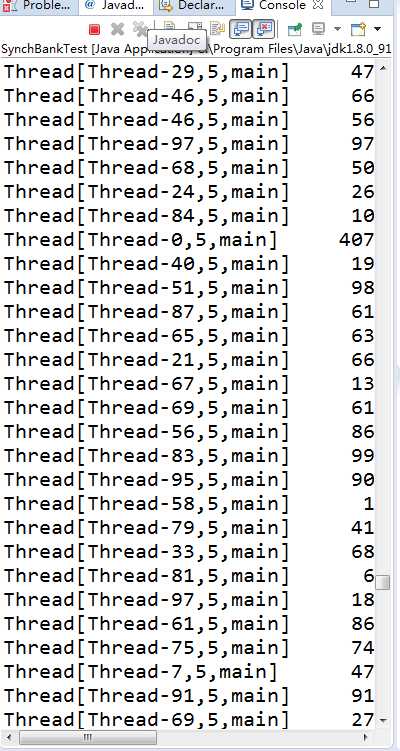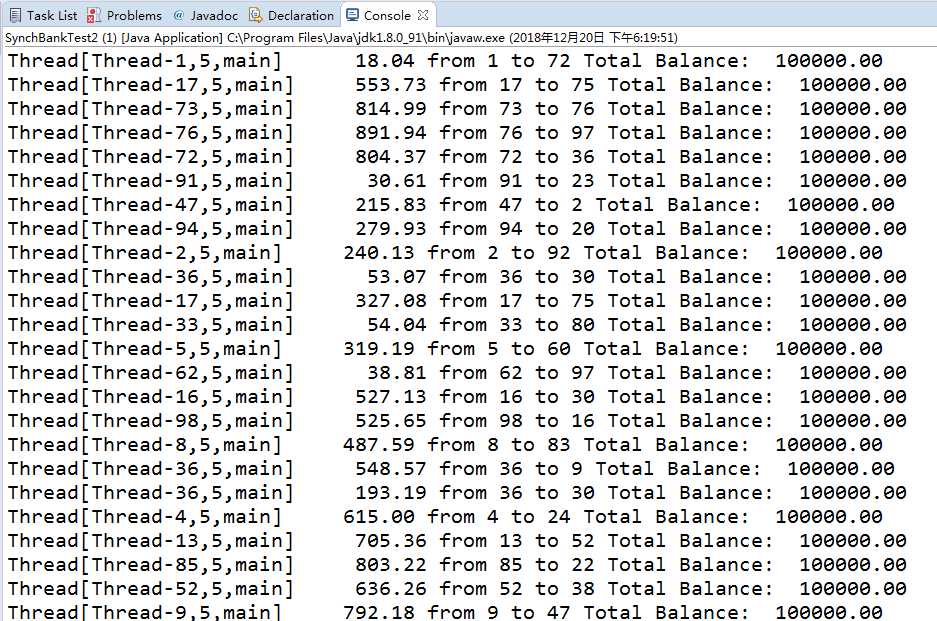马凯军201771010116《面向对象与程序设计Java》第十七周学习总结
Posted zero--
tags:
篇首语:本文由小常识网(cha138.com)小编为大家整理,主要介绍了马凯军201771010116《面向对象与程序设计Java》第十七周学习总结相关的知识,希望对你有一定的参考价值。
一.理论知识部分
Java 的线程调度采用优先级策略:优先级高的先执行,优先级低的后执行;多线程系统会自动为每个线程分配一个优先级,缺省时,继承其父类的优先级; 任务紧急的线程,其优先级较高; 同优先级的线程按“先进先出”的队列原则。
调用setPriority(int a)重置当前线程的优先级,a取值可以是前述的三个静态量。调用getPriority()获得当前线程优先级。
多线程并发运行不确定性问题解决方案:引入线程同步机制,使得另一线程要使用该方法,就只能等待。
在Java中解决多线程同步问题的方法有两种:J ava SE 5.0中引入ReentrantLock类。 在共享内存的类方法前加synchronized修饰符。
有关锁对象和条件对象的关键要点:锁用来保护代码片段,保证任何时刻只能有一个线程执行被保护的代码。锁管理试图进入被保护代码段的线程。锁可拥有一个或多个相关条件对象。每个条件对象管理那些已经进入被保护的代码 段但还不能运行的线程。
synchronized关键字作用: 某个类内方法用synchronized 修饰后,该方法被称为同步方法;只要某个线程正在访问同步方法,其他线程欲要访问同步方法就被阻塞,直至线程从同 步方法返回前唤醒被阻塞线程,其他线程方可能进入同步方法。
在同步方法中使用wait()、notify 和notifyAll()方法:一个线程在使用的同步方法中时,可能根据问题的需要,必须使用wait()方法使本线程等待,暂时让出CPU的使用权,并允许其它线程使用这个同步方法。线程如果用完同步方法,应当执行notifyAll()方 法通知所有由于使用这个同步方法而处于等待的线程结束等待。
实验十七 线程同步控制
实验时间 2018-12-10
1、实验目的与要求
(1) 掌握线程同步的概念及实现技术;
(2) 线程综合编程练习
2、实验内容和步骤
实验1:测试程序并进行代码注释。
测试程序1:
l 在Elipse环境下调试教材651页程序14-7,结合程序运行结果理解程序;
l 掌握利用锁对象和条件对象实现的多线程同步技术。
package synch; import java.util.*; /** * A bank with a number of bank accounts that uses synchronization primitives. * @version 1.30 2004-08-01 * @author Cay Horstmann */ public class Bank { private final double[] accounts; /** * Constructs the bank. * @param n the number of accounts * @param initialBalance the initial balance for each account */ public Bank(int n, double initialBalance) { accounts = new double[n]; Arrays.fill(accounts, initialBalance); } /** * Transfers money from one account to another. * @param from the account to transfer from * @param to the account to transfer to * @param amount the amount to transfer */ public synchronized void transfer(int from, int to, double amount) throws InterruptedException { while (accounts[from] < amount) wait(); System.out.print(Thread.currentThread()); accounts[from] -= amount; System.out.printf(" %10.2f from %d to %d", amount, from, to); accounts[to] += amount; System.out.printf(" Total Balance: %10.2f%n", getTotalBalance()); notifyAll(); } /** * Gets the sum of all account balances. * @return the total balance */ public synchronized double getTotalBalance() { double sum = 0; for (double a : accounts) sum += a; return sum; } /** * Gets the number of accounts in the bank. * @return the number of accounts */ public int size() { return accounts.length; } }
package synch; /** * This program shows how multiple threads can safely access a data structure. * @version 1.31 2015-06-21 * @author Cay Horstmann */ public class SynchBankTest { public static final int NACCOUNTS = 100; public static final double INITIAL_BALANCE = 1000; public static final double MAX_AMOUNT = 1000; public static final int DELAY = 10; public static void main(String[] args) { Bank bank = new Bank(NACCOUNTS, INITIAL_BALANCE); for (int i = 0; i < NACCOUNTS; i++) { int fromAccount = i; Runnable r = () -> { try { while (true) { int toAccount = (int) (bank.size() * Math.random()); double amount = MAX_AMOUNT * Math.random(); bank.transfer(fromAccount, toAccount, amount); Thread.sleep((int) (DELAY * Math.random())); } } catch (Interrupt

测试程序2:
l 在Elipse环境下调试教材655页程序14-8,结合程序运行结果理解程序;
l 掌握synchronized在多线程同步中的应用。
package synch2; import java.util.*; /** * A bank with a number of bank accounts that uses synchronization primitives. * @version 1.30 2004-08-01 * @author Cay Horstmann */ public class Bank { private final double[] accounts; /** * Constructs the bank. * @param n the number of accounts * @param initialBalance the initial balance for each account */ public Bank(int n, double initialBalance) { accounts = new double[n]; Arrays.fill(accounts, initialBalance); } /** * Transfers money from one account to another. * @param from the account to transfer from * @param to the account to transfer to * @param amount the amount to transfer */ public synchronized void transfer(int from, int to, double amount) throws InterruptedException { while (accounts[from] < amount) wait(); System.out.print(Thread.currentThread()); accounts[from] -= amount; System.out.printf(" %10.2f from %d to %d", amount, from, to); accounts[to] += amount; System.out.printf(" Total Balance: %10.2f%n", getTotalBalance()); notifyAll(); } /** * Gets the sum of all account balances. * @return the total balance */ public synchronized double getTotalBalance() { double sum = 0; for (double a : accounts) sum += a; return sum; } /** * Gets the number of accounts in the bank. * @return the number of accounts */ public int size() { return accounts.length; } }
package synch2; /** * This program shows how multiple threads can safely access a data structure, * using synchronized methods. * @version 1.31 2015-06-21 * @author Cay Horstmann */ public class SynchBankTest2 { public static final int NACCOUNTS = 100; public static final double INITIAL_BALANCE = 1000; public static final double MAX_AMOUNT = 1000; public static final int DELAY = 10; public static void main(String[] args) { Bank bank = new Bank(NACCOUNTS, INITIAL_BALANCE); for (int i = 0; i < NACCOUNTS; i++) { int fromAccount = i; Runnable r = () -> { try { while (true) { int toAccount = (int) (bank.size() * Math.random()); double amount = MAX_AMOUNT * Math.random(); bank.transfer(fromAccount, toAccount, amount); Thread.sleep((int) (DELAY * Math.random())); } } catch (InterruptedException e) { } }; Thread t = new Thread(r); t.start(); } } }

测试程序3:
l 在Elipse环境下运行以下程序,结合程序运行结果分析程序存在问题;
l 尝试解决程序中存在问题。
|
class Cbank { private static int s=2000; public static void sub(int m) { int temp=s; temp=temp-m; try { Thread.sleep((int)(1000*Math.random())); } catch (InterruptedException e) { } s=temp; System.out.println("s="+s); } }
class Customer extends Thread { public void run() { for( int i=1; i<=4; i++) Cbank.sub(100); } } public class Thread3 { public static void main(String args[]) { Customer customer1 = new Customer(); Customer customer2 = new Customer(); customer1.start(); customer2.start(); } } |

实验2 编程练习
利用多线程及同步方法,编写一个程序模拟火车票售票系统,共3个窗口,卖10张票,程序输出结果类似(程序输出不唯一,可以是其他类似结果)。
Thread-0窗口售:第1张票
Thread-0窗口售:第2张票
Thread-1窗口售:第3张票
Thread-2窗口售:第4张票
Thread-2窗口售:第5张票
Thread-1窗口售:第6张票
Thread-0窗口售:第7张票
Thread-2窗口售:第8张票
Thread-1窗口售:第9张票
Thread-0窗口售:第10张票
package synch; public class SynchBankTest { /** * java多线程同步锁的使用 * 示例:三个售票窗口同时出售10张票 * */ public static void main(String[] args) { //实例化站台对象,并为每一个站台取名字 Station station1=new Station("窗口1"); Station station2=new Station("窗口2"); Station station3=new Station("窗口3"); // 让每一个站台对象各自开始工作 station1.start(); station2.start(); station3.start(); } }
package synch; public class Station extends Thread { // 通过构造方法给线程名字赋值 public Station(String name) { super(name);// 给线程名字赋值 } // 为了保持票数的一致,票数要静态 static int tick = 10; // 创建一个静态钥匙 static Object ob = "aa";//值是任意的 // 重写run方法,实现买票操作 @Override public void run() { while (tick > 0) { synchronized (ob) {// 这个很重要,必须使用一个锁, // 进去的人会把钥匙拿在手上,出来后才把钥匙拿让出来 if (tick > 0) { System.out.println(getName() + "售出了第" + tick + "张票"); tick--; } else { System.out.println("票卖完了"); } } try { sleep(1000);//休息一秒 } catch (InterruptedException e) { e.printStackTrace(); } } } }

实验总结:
通过这次实验学习到了很多东西,主要掌握了多线程在程序中的的实现。本周实验还是挺轻松的,自己顺利的完成了。
以上是关于马凯军201771010116《面向对象与程序设计Java》第十七周学习总结的主要内容,如果未能解决你的问题,请参考以下文章
马凯军201771010116《面向对象与程序设计Java》第十五周学习知识总结
马凯军201771010116《面向对象与程序设计Java》第十二周学习总结
马凯军201771010116《面向对象与程序设计Java》第九周学习总结
马凯军201771010116《面向对象程序设计(java)》第一周学习总结